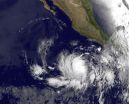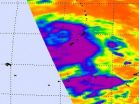(Press-News.org) BLOOMINGTON, Ind. -- Two popular MTV programs about teenage pregnancy -- "16 and Pregnant" and "Teen Mom" -- were met with national debate. Critics said the shows glamorized teenage pregnancy, while supporters said they discouraged it.
A new study by an Indiana University professor suggests they're both right.
The study, which will appear in the journal Sexuality & Culture, focused on female students because of the high dropout rate associated with pregnancy among this demographic.
When the programs were under development, MTV sought the consultation of The National Campaign to Prevent Teen and Unplanned Pregnancy.
"The programs were developed to show young women how difficult it is to be a teen mom," said the lead author, Paul Wright, an assistant professor of telecommunications in the IU College of Arts and Sciences. "They were intended to be program-length public service announcements discouraging teen pregnancy.
"But critics said the programs sent mixed messages. My viewing of the programs suggested the same," Wright said. "On one hand, the programs do show many of the difficulties teen mothers face. But on the other hand, they sometimes seem to send the message that getting pregnant was all for the best.
"The hypothesis driving our study was that the family background of the viewer might determine whether they focused on the negatives or the positives," Wright said.
Consistent with this assumption, frequent viewers of the programs whose fathers often communicated about sex with them while they were growing up were the least likely to have recently had sex.
Conversely, frequent viewers of the programs whose fathers rarely communicated about sex with them while they were growing up were the most likely to have recently had sex.
Writing in the study, Wright added, "Fathers who communicate with daughters about sex are especially apt to talk about the negatives of premarital sex, to speak of males' propensity for placing sexual pressure on females, and to point out the consequences that result from the risky sexual behavior of others.
"Females who have been regularly sent these types of messages should be especially likely to attend to the negatives of being a young mother depicted on '16 and Pregnant' and 'Teen Mom.'"
No interaction was found in the study between mother-daughter sexual communication, viewing frequency and recent intercourse behavior.
"In this study, there was only what we call an 'interaction' for fathers," Wright said. "But this doesn't mean that mother-daughter communication is irrelevant. There are other studies showing that the more moms communicate about sex, the less likely it is their daughters will either have sex or engage in risky sex."
For this study, survey data were collected from 313 female undergraduates at two universities in the southwestern United States. All participants were unmarried. About 40 percent were 19 or younger. About 75 percent were 21 or younger. College students are a key audience for MTV.
White participants comprised 56.5 percent of the sample, while others were Hispanic (18.5 percent), Asian (13.1 percent), African-American (4.2 percent) and Middle Eastern (1 percent). Whites were more likely than nonwhites to view both programs, which may be because most of the mothers on the programs also are white.
Nearly 65 percent of the women identified themselves as being Christian; 4.8 percent were Jewish; 1.9 percent were Buddhist; 1.3 percent, Muslim; and 0.6 percent, Hindu. Fifteen percent said they belonged to another religion and 11.5 were not religious.
Wright's previous research supports the hypotheses that mainstream media's portrayal of sex as a recreational activity without consequences has contributed to risky behavior among young people. His research also focuses on the role of parents in the sexual development of their children.
### Co-authors on the paper are Ashley K. Randall, a Ph.D. candidate in family studies and human development, and Analisa Arroyo, a Ph.D. candidate in communication, both at the University of Arizona.
Viewers' family background affects how they react to MTV shows 16 and Pregnant, Teen Mom
2012-05-23
ELSE PRESS RELEASES FROM THIS DATE:
Civil engineers find savings where the rubber meets the road
2012-05-23
CAMBRIDGE, Mass. -- A new study by civil engineers at MIT shows that using stiffer pavements on the nation's roads could reduce vehicle fuel consumption by as much as 3 percent — a savings that could add up to 273 million barrels of crude oil per year, or $15.6 billion at today's oil prices. This would result in an accompanying annual decrease in CO2 emissions of 46.5 million metric tons.
The study, released in a recent peer-reviewed report, is the first to use mathematical modeling rather than roadway experiments to look at the effect of pavement deflection on vehicle ...
VCU Massey Cancer Center sees potential in novel leukemia treatment
2012-05-23
Richmond, Va. – (May 22, 2012) – Scientists at Virginia Commonwealth University Massey Cancer Center may be one step closer to developing a new therapy for acute myeloid leukemia (AML) after discovering that the targeted agents obatoclax and sorafenib kill leukemia cells much more effectively when combined than when the drugs are administered individually.
Recently published in the journal Blood, the results of a study led by Steven Grant, M.D., Shirley Carter Olsson and Sture Gordon Olsson Chair in Oncology Research, associate director for translational research and program ...
Scientists unravel role of fusion gene in prostate cancer
2012-05-23
NEW YORK (May 22, 2012) -- Up to half of all prostate cancer cells have a chromosomal rearrangement that results in a new "fusion" gene and formation of its unique protein -- but no one has known how that alteration promotes cancer growth. Now, Weill Cornell Medical College researchers have found that in these cancer cells, the 3-D architecture of DNA, wrapped up in a little ball known as a chromatin, is warped in such a way that a switch has been thrown on thousands of genes, turning them on or off to promote abnormal, unchecked growth. Researchers also found that new ...
Breast cancer clinical trial tests combo of heat shock protein inhibitor and hormonal therapy
2012-05-23
CAMBRIDGE, Mass. (May 22, 2012) – Pushed to the brink of survival, the hyper-driven cells of a cancerous tumor tap into an ancient system that has helped organisms cope with internal stresses and environmental challenges since life began. As an integral part of this system, heat shock protein 90 (HSP90) has been shown to help malignant cells accommodate the genetic changes and profound disturbances in normal biology that occur in cancers.
Researchers have theorized that inhibiting HSP90 just might render breast cancer cells less likely to escape the challenge posed ...
New study shows how nanotechnology can help detect disease earlier
2012-05-23
LEXINGTON, KY. (May 21, 2012) — A new study led by University of Kentucky researchers shows a new way to precisely detect a single chemical at extremely low concentrations and high contamination.
The study, published online for ACS Nano, was carried out in the laboratory of Peixuan Guo, the William S. Farish Endowed Chair in Nanobiotechnology at the University of Kentucky Markey Cancer Center. The study shows that the phi29 DNA packaging nanomotor connector can be used to sense chemicals with reactive thioesters or maleimide using single channel conduction assays based ...
The older we get, the less we know (cosmologically)
2012-05-23
The universe is a marvelously complex place, filled with galaxies and larger-scale structures that have evolved over its 13.7-billion-year history. Those began as small perturbations of matter that grew over time, like ripples in a pond, as the universe expanded. By observing the large-scale cosmic wrinkles now, we can learn about the initial conditions of the universe. But is now really the best time to look, or would we get better information billions of years into the future - or the past?
New calculations by Harvard theorist Avi Loeb show that the ideal time to study ...
Psychological Science explains uproar over prostate-cancer screenings
2012-05-23
WASHINGTON— The uproar that began last year when the U.S. Preventive Services Task Force stated that doctors should no longer offer regular prostate-cancer tests to healthy men continued this week when the task force released their final report. Overall, they stuck to their guns, stating that a blood test commonly used to screen for prostate cancer, the PSA test, causes more harm than good — it leads men to receive unnecessary, and sometimes even dangerous, treatments.
But many people simply don't believe that the test is ineffective. Even faced with overwhelming evidence, ...
Array of light for early disease detection?
2012-05-23
A special feature in this week's issue of the journal Science highlights protein array technology, touching on research conducted by Joshua LaBaer, director of the Biodesign Institute's Virginia G. Piper Center for Personalized Diagnostics.
With the successful completion of the Human Genome Project, research attention is increasingly focusing on proteins. Versatile products produced from genetic templates, proteins are principle actors in both the maintenance of health and the onset of illness. Protein microarrays are a means of bridging the gap between analysis of the ...
NASA Sees Eastern Pacific's Second Tropical Storm Form
2012-05-23
On May 21, NASA satellites were monitoring Tropical Depression 02E in the eastern Pacific Ocean, and 24 hours later it strengthened into the second tropical storm of the season. Tropical Storm Bud was captured by NOAA's GOES-13 satellite on May 22, and appears to be well-formed.
Tropical Storm Bud isn't going to stop there, however. According to the forecasters at the National Hurricane Center, Bud is expected to become a hurricane because of light to moderate wind shear and warm sea surface temperatures.
On May 22 at 0900 UTC (2 a.m. PDT/5 a.m. EDT), Tropical Storm ...
NASA satellite sees Tropical Storm Sanvu pass Guam, strengthen
2012-05-23
Tropical Depression 03W in the western North Pacific did exactly what forecasters expected over the last twenty-four hours: it became a tropical storm named Sanvu and passed west of Guam on a northwesterly track.
On May 22 at 0900 UTC (5 a.m. EDT), Tropical Storm Sanvu was more than 100 miles west-northwest of Andersen Air Force Base, Guam, and still over 600 nautical miles south of Iwo To, Japan and headed in that direction. Sanvu's center was located near 15.2 North and 141.9. East. It was still churning up rough surf around Guam. Sanvu has maximum sustained winds near ...


